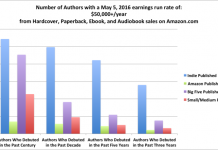 Phil Ollila, Chief Content Officer, Ingram Group: distribution really matters now. Traditional publishers got to watch the changes in retail business as the big chains rose up but deidn’t have to do much. Now this is not the case, publishing industry is changing along with the retail side and both are involved on a daily basis. Total sales of books in vatious forms will increase, but total number of print books will decrease. Samhain is a romance publisher who is widely distributed, but they outsorce everything excpet for content filters. Everything they do is in trade paper but it’s all print on demand. Everything is a variable cost for them, except management. Expects to see more genre publishers appearing because barriers to entry are becoming so low. Last year went from 3M to 6M titles in Lightning Source. The problem is marketing.
Phil Ollila, Chief Content Officer, Ingram Group: distribution really matters now. Traditional publishers got to watch the changes in retail business as the big chains rose up but deidn’t have to do much. Now this is not the case, publishing industry is changing along with the retail side and both are involved on a daily basis. Total sales of books in vatious forms will increase, but total number of print books will decrease. Samhain is a romance publisher who is widely distributed, but they outsorce everything excpet for content filters. Everything they do is in trade paper but it’s all print on demand. Everything is a variable cost for them, except management. Expects to see more genre publishers appearing because barriers to entry are becoming so low. Last year went from 3M to 6M titles in Lightning Source. The problem is marketing.
Robert Miller, Group Publisher Workman Publishing, moderator.
Larry Kirshbaum, Founder/Agent, LJK Literary Management: rise of self-publishing is causing a huge problem for publishers. Publishers are becoming more cautious in the books they are picking up and are watching expenditures very carefully. 10 years ago did ebooks at Warner and it was an absolute disaster. The market wasn’t ready then. Certain kinds of books not getting the advances or attention from publishers that they once did, so more often telling authors they might be better off doing it themselves by self-publishing. Today editors have less say and the marketing and financil people are involved in making the decision. Publishers want authors to have a “platform” before they will publish them, especially with genre fiction, and self-publishing helps them build a platform which will make them more attractive for publishers. Rich and poor dichotomy in the business. The name brand authors still getting big advances and that’s what they focus on and that’s what pays the bills. With respect to mid-list books or category books, publishers are more queasy and self-publishing serves as a farm system. Dealing with one romance author who self-published at 99 cents and sold 2 copies during the first week and last weekend she sold 6,000 copies through Amazon, etc. Publishers are not interested in her. Their agency is wrestling with the question of how do they get revenue from self-published authors. More agents looking into becoming publishers, for example Open Road. Really likes the analogy of self-publishing as a farm system, gives publishers the data they are looking for to make a decision. In the trade area it’s the Wild West right now and there is a lot of opportunity.
Philip Ruppel, President, McGraw-Hill Professional: customers are looking at other methods of getting content than from the book. McGraw’s fixation is how do their customers want to get content and to make that content available, no matter what the format. Publish 1,000 books a year and have to make this evaluation for each book. Need to develop a direct relationship to customers to do this. Self-publishing doesn’t work for the technical content that they publish. They provide an enormous value with the teams of editors who vet the content and validate the information. Curation is still very important in their business. Finding competitors are no journals or publishers but are software aggregators, for example. Believe that we are reading more than ever. Commutes and it used to be that when got to Grand Central Station the bins would be full of newspapers, and when he gets off the train today the bins are 1/4 full. People reading on devices. For professional publishers you know you will sell sell only a few copies (in the low thousands) and so can’t be forced to price it lower because can’t afford the content then. With small print runs need to keep the prices up, and the challenge is to provide content that is worth this.
Jeffrey Mathews, Vice President, Scholastic: Children’s market has been slower to move to digital. The children’s space is more complicated with authors, illustrator, parents, schools and grandparents all pitching in. See an opportunity to expand the market with technology. Can reach new kinds of kids who weren’t reading before. Print represents a small percentage of the cost in the value chain. The fear is that in the drive for lower prices and higher royalties we reduce the amount of books published and make the pie smaller. Sell 500M books a year in print and books are a pretty good experience for kids. To date the children’s ebook market hasn’t blossomed because there aren’t the right devices, at the right price points, for kids. Children’s stuff moving to apps but the problem is getting it known to the public. If not in top 10 in the App Store will never be noticed.

































